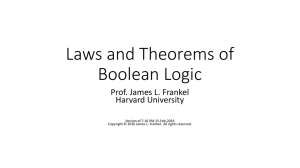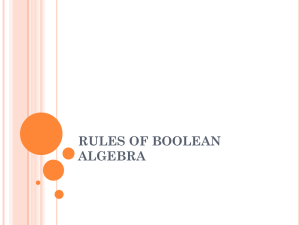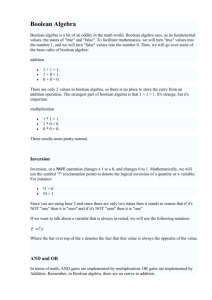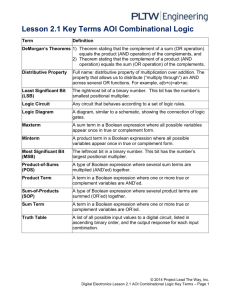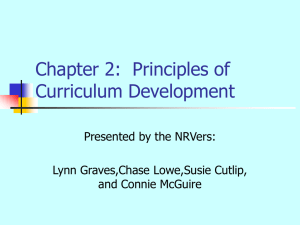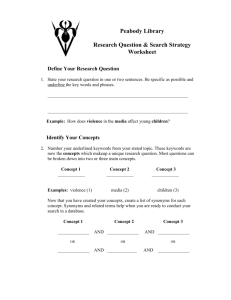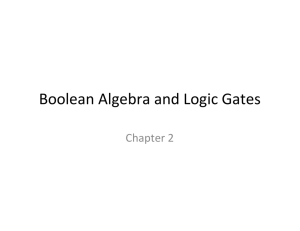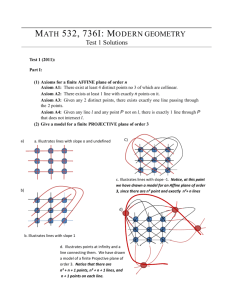Boolean Algebra
advertisement
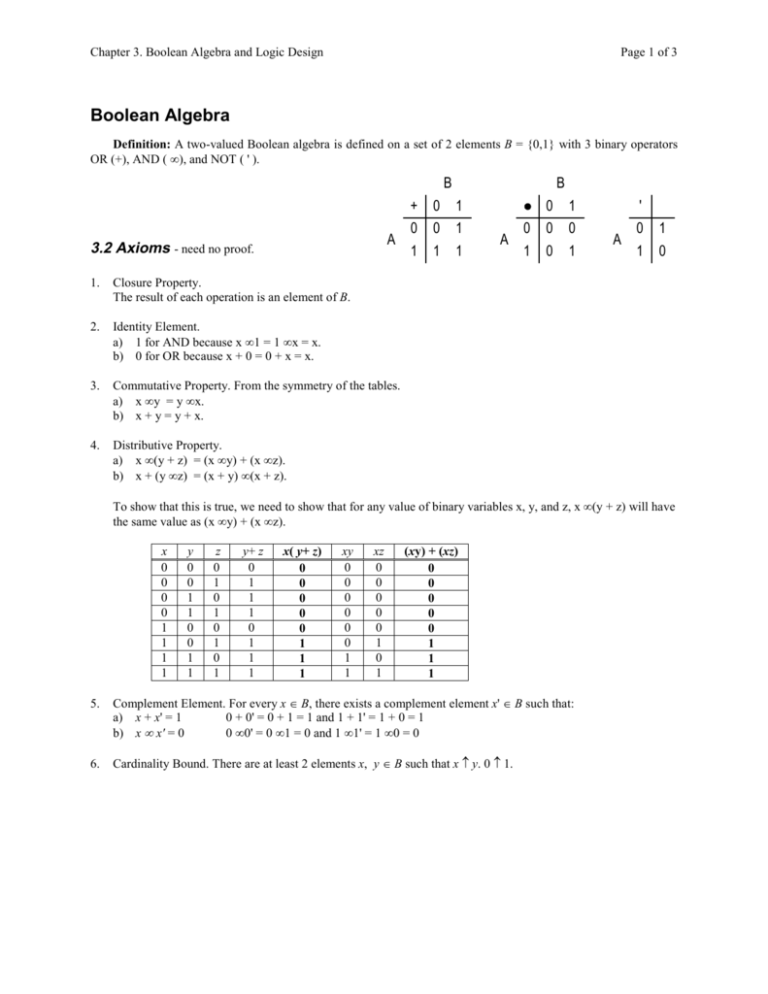
Chapter 3. Boolean Algebra and Logic Design
Page 1 of 3
Boolean Algebra
Definition: A two-valued Boolean algebra is defined on a set of 2 elements B = {0,1} with 3 binary operators
OR (+), AND ( • ), and NOT ( ' ).
B
+
0
A
1
3.2 Axioms - need no proof.
1.
Closure Property.
The result of each operation is an element of B.
2.
Identity Element.
a) 1 for AND because x • 1 = 1 • x = x.
b) 0 for OR because x + 0 = 0 + x = x.
3.
Commutative Property. From the symmetry of the tables.
a) x • y = y • x.
b) x + y = y + x.
4.
Distributive Property.
a) x • (y + z) = (x • y) + (x • z).
b) x + (y • z) = (x + y) • (x + z).
0
0
1
B
1
1
1
A
0
1
0
0
0
1
0
1
A
'
0
1
1
0
To show that this is true, we need to show that for any value of binary variables x, y, and z, x • (y + z) will have
the same value as (x • y) + (x • z).
x
0
0
0
0
1
1
1
1
y
0
0
1
1
0
0
1
1
z
0
1
0
1
0
1
0
1
y+ z
0
1
1
1
0
1
1
1
x( y+ z)
0
0
0
0
0
1
1
1
xy
0
0
0
0
0
0
1
1
xz
0
0
0
0
0
1
0
1
(xy) + (xz)
0
0
0
0
0
1
1
1
5.
Complement Element. For every x ∈ B, there exists a complement element x' ∈ B such that:
a) x + x' = 1
0 + 0' = 0 + 1 = 1 and 1 + 1' = 1 + 0 = 1
0 • 0' = 0 • 1 = 0 and 1 • 1' = 1 • 0 = 0
b) x • x' = 0
6.
Cardinality Bound. There are at least 2 elements x, y ∈ B such that x ≠ y. 0 ≠ 1.
Chapter 3. Boolean Algebra and Logic Design
Page 2 of 3
3.3 Basic Theorems - need to be proven.
1.
Idempotency.
a) x + x = x.
b) x• x = x.
2.
a) x + 1 = 1.
b) x • 0 = 0.
3.
Absorption.
a) yx + x = x
b) (y + x)x = x
4.
Involution.
a) (x')' = x
5.
Associative.
a) (x + y) + z = x + (y + z)
b) x (y z) = (x y) z
Proof of 1a)
x + x = (x + x) • 1
= (x + x) (x + x')
= x + xx'
=x+0
=x
by Axiom 2a
by Axiom 5a
by Axiom 4b
by Axiom 5b
by Axiom 2b
Proof of 3a)
yx + x = yx + 1x
= x(y + 1)
= x1
=x
by Axiom 2a
by Axiom 4a
by Theorem 2a
by Axiom 2a
Proof of 3b)
(y + x)x= xy + xx
= xy + x
=x
by Axiom 4a
by Theorem 1b
by Theorem 3a
Proof of 3b)
x
0
0
1
1
De Morgan's Law.
a) (x + y)' = x' y'
b) (x y)' = x' + y'
y
0
1
0
1
y+x
0
1
1
1
(y+x) x
0
0
1
1
Duality Principle.
This principle states that any algebraic equality derived from these axioms will still be valid whenever the OR and
AND operators, and identity elements 0 and 1, have been interchanged. i.e. changing every OR into AND and vice
versa, and every 0 into 1 and vice versa.
Ex. Theorem 1b) follows from Theorem 1a) by the duality principle.
3.4 Boolean Functions
Boolean functions are formed from binary variables and the Boolean operators AND, OR, and NOT. For a given
value of the variables, the value of the function is either 0 or 1. e.g.
3 AND terms
F1 = x y + x y' z + x' y z
2 litererals
This function equals 1 if:
x = 1 and y = 1 (doesn't matter what z is)
x = 1, y = 0, and z = 1
x = 0, y = 1, and z = 1
otherwise, F1 = 0.
3 litererals
Chapter 3. Boolean Algebra and Logic Design
Page 3 of 3
Boolean functions can also be defined by a truth table:
x
0
0
0
0
1
1
1
1
Variable Values
y
0
0
1
1
0
0
1
1
x y z + x y z' = x y (z + z')
= x y (1)
=xy
Function Values
F1
F1'
0
1
0
1
0
1
1
0
0
1
1
0
1
0
1
0
z
0
1
0
1
0
1
0
1
3.4.1 Complement of a Function
The complement of any function F is F '. Its value can be obtained by interchanging the 0's for 1's and 1's for 0's in
the value of F.
There are two ways to determine the algebraic expression for the complement of a function:
1.
Apply the generalized form of De Morgan's Law as many times as necessary.
Ex. F '= (x y + x y' z + x' y z)'
= (x y)' (x y' z)' (x' y z)'
= (x' + y') (x' + y + z') (x + y' + z')
Difficult to see when F ' = 1. Easier to see when F ' = 0. F ' = 0 when each term is 0.
2.
Use the duality principle, i.e. interchange the AND and OR operators, and by complementing each literal.
Ex. (x y) ⇒ (x' + y')
(x y' z) ⇒ (x' + y + z')
(x' y z) ⇒ (x + y' + z')
therefore, (x y) + (x y' z) + (x' y z) ⇒ (x' + y') (x' + y + z') (x + y' + z')
The same function can be specified by two or more different algebraic expressions.
3.4.2 Graphic representation
Boolean functions can be expressed graphically by connecting together AND, OR, and NOT operators, as specified
by the algebraic expression that was used to define the function.
Ex. F1 = (x y) + (x y' z) + (x' y z)
x
y
z
F = xy + xy'z + x'yz
xy
xy'
+ xy + xy'z
xy'z
+
F
xy'z
F'
x'y
